warning OPEL VIVARO C 2020.25 Manual user
[x] Cancel search | Manufacturer: OPEL, Model Year: 2020.25, Model line: VIVARO C, Model: OPEL VIVARO C 2020.25Pages: 287, PDF Size: 28.79 MB
Page 240 of 287
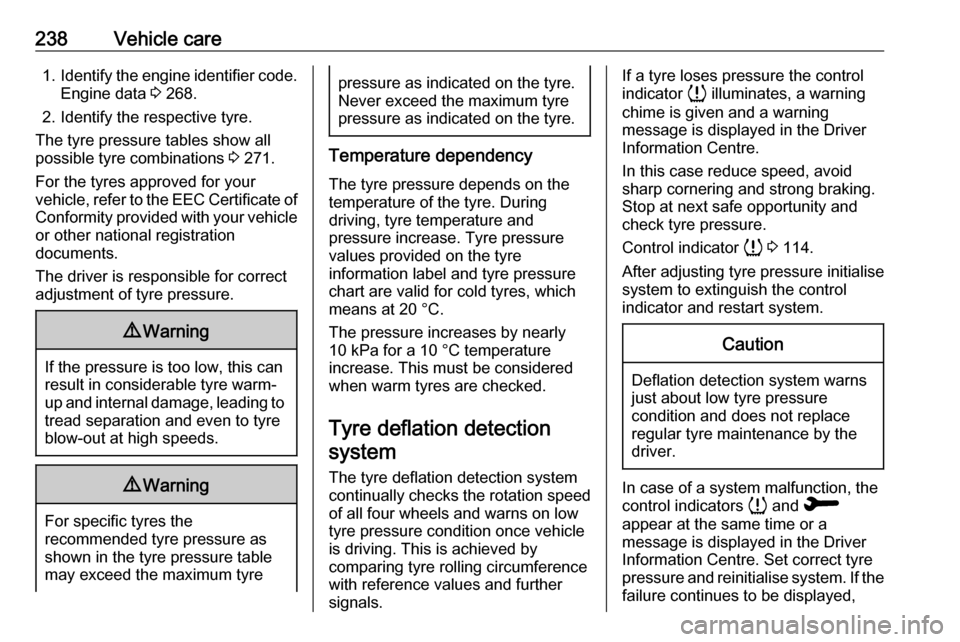
238Vehicle care1.Identify the engine identifier code.
Engine data 3 268.
2. Identify the respective tyre.
The tyre pressure tables show all
possible tyre combinations 3 271.
For the tyres approved for your
vehicle, refer to the EEC Certificate of
Conformity provided with your vehicle or other national registration
documents.
The driver is responsible for correct
adjustment of tyre pressure.9 Warning
If the pressure is too low, this can
result in considerable tyre warm-
up and internal damage, leading to tread separation and even to tyre
blow-out at high speeds.
9 Warning
For specific tyres the
recommended tyre pressure as
shown in the tyre pressure table may exceed the maximum tyre
pressure as indicated on the tyre.
Never exceed the maximum tyre
pressure as indicated on the tyre.
Temperature dependency
The tyre pressure depends on the
temperature of the tyre. During
driving, tyre temperature and
pressure increase. Tyre pressure
values provided on the tyre
information label and tyre pressure
chart are valid for cold tyres, which means at 20 °C.
The pressure increases by nearly
10 kPa for a 10 °C temperature
increase. This must be considered
when warm tyres are checked.
Tyre deflation detectionsystem
The tyre deflation detection system
continually checks the rotation speed
of all four wheels and warns on low
tyre pressure condition once vehicle
is driving. This is achieved by
comparing tyre rolling circumference
with reference values and further
signals.
If a tyre loses pressure the control
indicator q illuminates, a warning
chime is given and a warning
message is displayed in the Driver
Information Centre.
In this case reduce speed, avoid
sharp cornering and strong braking.
Stop at next safe opportunity and
check tyre pressure.
Control indicator q 3 114.
After adjusting tyre pressure initialise
system to extinguish the control
indicator and restart system.Caution
Deflation detection system warns
just about low tyre pressure
condition and does not replace
regular tyre maintenance by the
driver.
In case of a system malfunction, the
control indicators q and R
appear at the same time or a
message is displayed in the Driver
Information Centre. Set correct tyre
pressure and reinitialise system. If the
failure continues to be displayed,
Page 242 of 287
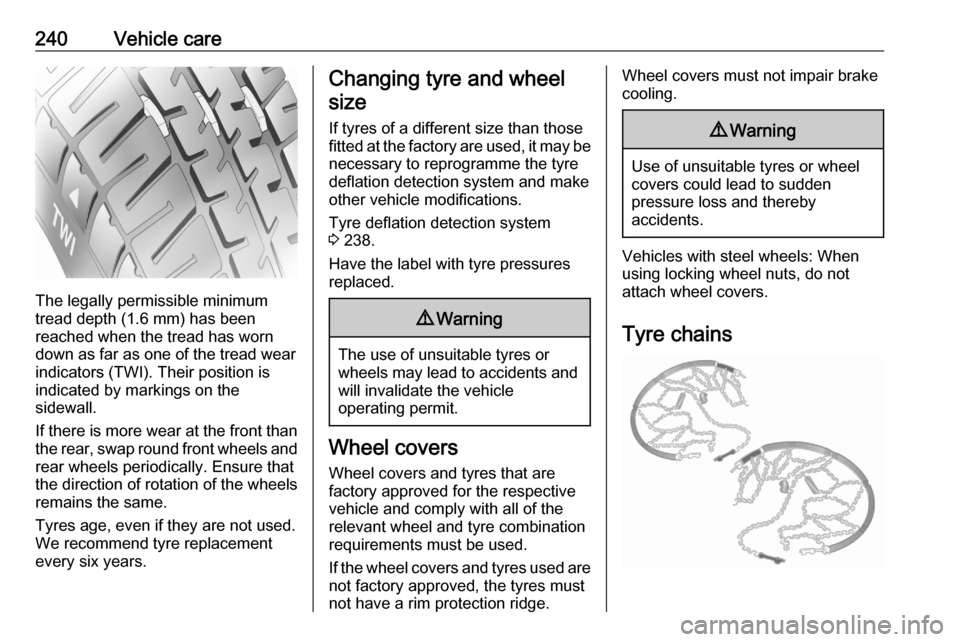
240Vehicle care
The legally permissible minimum
tread depth (1.6 mm) has been
reached when the tread has worn
down as far as one of the tread wear
indicators (TWI). Their position is
indicated by markings on the
sidewall.
If there is more wear at the front than
the rear, swap round front wheels and rear wheels periodically. Ensure that
the direction of rotation of the wheels
remains the same.
Tyres age, even if they are not used.
We recommend tyre replacement
every six years.
Changing tyre and wheel
size
If tyres of a different size than those
fitted at the factory are used, it may be necessary to reprogramme the tyre
deflation detection system and make
other vehicle modifications.
Tyre deflation detection system
3 238.
Have the label with tyre pressures
replaced.9 Warning
The use of unsuitable tyres or
wheels may lead to accidents and will invalidate the vehicle
operating permit.
Wheel covers
Wheel covers and tyres that are
factory approved for the respective
vehicle and comply with all of the
relevant wheel and tyre combination
requirements must be used.
If the wheel covers and tyres used are
not factory approved, the tyres must
not have a rim protection ridge.
Wheel covers must not impair brake
cooling.9 Warning
Use of unsuitable tyres or wheel
covers could lead to sudden
pressure loss and thereby
accidents.
Vehicles with steel wheels: When
using locking wheel nuts, do not
attach wheel covers.
Tyre chains
Page 243 of 287
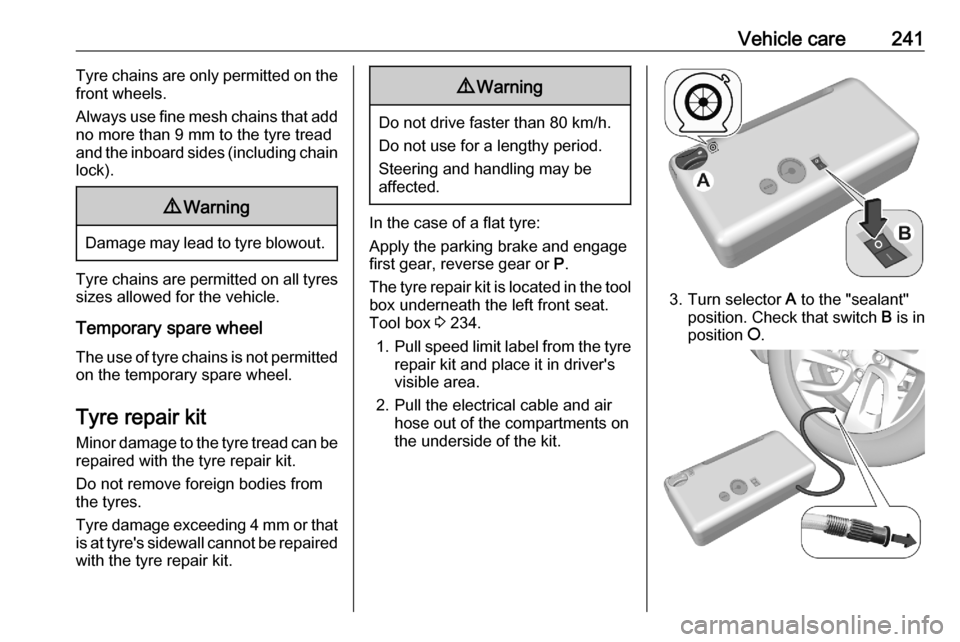
Vehicle care241Tyre chains are only permitted on the
front wheels.
Always use fine mesh chains that add
no more than 9 mm to the tyre tread
and the inboard sides (including chain lock).9 Warning
Damage may lead to tyre blowout.
Tyre chains are permitted on all tyres
sizes allowed for the vehicle.
Temporary spare wheel
The use of tyre chains is not permitted on the temporary spare wheel.
Tyre repair kit
Minor damage to the tyre tread can be
repaired with the tyre repair kit.
Do not remove foreign bodies from
the tyres.
Tyre damage exceeding 4 mm or that
is at tyre's sidewall cannot be repaired with the tyre repair kit.
9 Warning
Do not drive faster than 80 km/h.
Do not use for a lengthy period.
Steering and handling may be
affected.
In the case of a flat tyre:
Apply the parking brake and engage
first gear, reverse gear or P.
The tyre repair kit is located in the tool
box underneath the left front seat.
Tool box 3 234.
1. Pull speed limit label from the tyre
repair kit and place it in driver's
visible area.
2. Pull the electrical cable and air hose out of the compartments on
the underside of the kit.
3. Turn selector A to the "sealant"
position. Check that switch B is in
position J.
Page 247 of 287
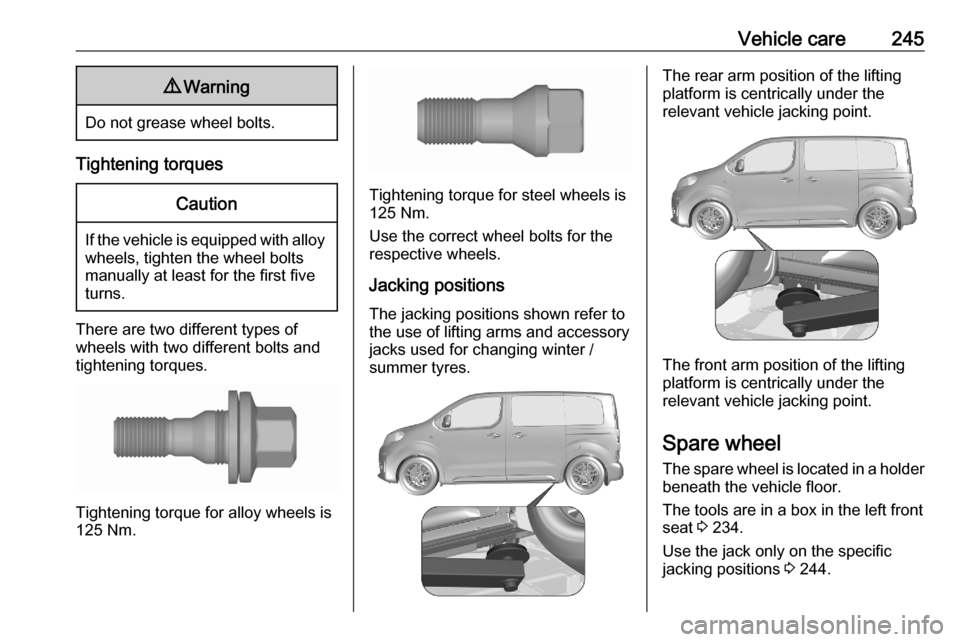
Vehicle care2459Warning
Do not grease wheel bolts.
Tightening torques
Caution
If the vehicle is equipped with alloy
wheels, tighten the wheel bolts
manually at least for the first five
turns.
There are two different types of
wheels with two different bolts and tightening torques.
Tightening torque for alloy wheels is
125 Nm.
Tightening torque for steel wheels is
125 Nm.
Use the correct wheel bolts for the respective wheels.
Jacking positions The jacking positions shown refer tothe use of lifting arms and accessoryjacks used for changing winter /
summer tyres.
The rear arm position of the lifting
platform is centrically under the
relevant vehicle jacking point.
The front arm position of the lifting
platform is centrically under the
relevant vehicle jacking point.
Spare wheel The spare wheel is located in a holder
beneath the vehicle floor.
The tools are in a box in the left front
seat 3 234.
Use the jack only on the specific
jacking positions 3 244.
Page 249 of 287
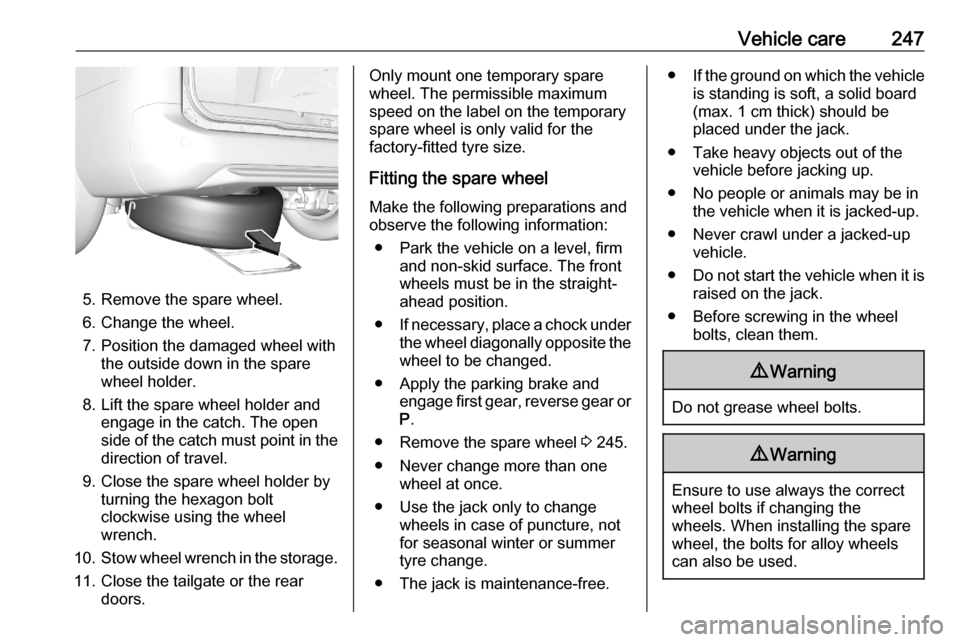
Vehicle care247
5. Remove the spare wheel.
6. Change the wheel.
7. Position the damaged wheel with the outside down in the spare
wheel holder.
8. Lift the spare wheel holder and engage in the catch. The open
side of the catch must point in the
direction of travel.
9. Close the spare wheel holder by turning the hexagon bolt
clockwise using the wheel
wrench.
10. Stow wheel wrench in the storage.
11. Close the tailgate or the rear doors.
Only mount one temporary spare
wheel. The permissible maximum
speed on the label on the temporary
spare wheel is only valid for the
factory-fitted tyre size.
Fitting the spare wheel
Make the following preparations and
observe the following information:
● Park the vehicle on a level, firm and non-skid surface. The front
wheels must be in the straight- ahead position.
● If necessary, place a chock under
the wheel diagonally opposite the
wheel to be changed.
● Apply the parking brake and engage first gear, reverse gear or
P .
● Remove the spare wheel 3 245.
● Never change more than one wheel at once.
● Use the jack only to change wheels in case of puncture, not
for seasonal winter or summer
tyre change.
● The jack is maintenance-free.● If the ground on which the vehicle
is standing is soft, a solid board
(max. 1 cm thick) should be
placed under the jack.
● Take heavy objects out of the vehicle before jacking up.
● No people or animals may be in the vehicle when it is jacked-up.
● Never crawl under a jacked-up vehicle.
● Do not start the vehicle when it is
raised on the jack.
● Before screwing in the wheel bolts, clean them.9Warning
Do not grease wheel bolts.
9Warning
Ensure to use always the correct
wheel bolts if changing the
wheels. When installing the spare
wheel, the bolts for alloy wheels can also be used.
Page 252 of 287

250Vehicle careJump startingDo not start with quick charger.
A vehicle with a discharged vehicle
battery can be started using jump
leads and the vehicle battery of
another vehicle.9 Warning
Be extremely careful when starting
with jump leads. Any deviation
from the following instructions can
lead to injuries or damage caused
by battery explosion or damage to the electrical systems of both
vehicles.
9 Warning
Avoid contact of the battery with
eyes, skin, fabrics and painted
surfaces. The fluid contains
sulphuric acid which can cause
injuries and damage in the event
of direct contact.
● Never expose the vehicle battery
to naked flames or sparks.
● A discharged vehicle battery can already freeze at a temperature
of 0 °C. Defrost the frozen battery before connecting jump leads.
● Wear eye protection and protective clothing when
handling a battery.
● Use a booster battery with the same voltage (12 V). Its capacity
(Ah) must not be much less than
that of the discharged vehicle battery.
● Use jump leads with insulated terminals and a cross section of
at least 16 mm 2
(25 mm 2
for
diesel engines).
● Do not disconnect the discharged
vehicle battery from the vehicle.
● Switch off all unnecessary electrical consumers.
● Do not lean over the vehicle battery during jump starting.
● Do not allow the terminals of one
lead to touch those of the other
lead.● The vehicles must not come into contact with each other during
the jump starting process.
● Apply the parking brake, transmission in neutral,
automatic transmission in P.
Open the positive terminal protection
caps of both vehicle batteries.
Lead connection order: 1. Connect the red lead to the positive terminal of the booster
battery.
2. Connect the other end of the red lead to the positive terminal of the
discharged battery.
Page 258 of 287

256Vehicle careCaution
Close Velcro fasteners as open
Velcro fasteners on clothing could damage seat upholstery.
The same applies to clothing with
sharp-edged objects, like zips or
belts or studded jeans.
Plastic and rubber parts
Plastic and rubber parts can be
cleaned with the same cleaner as
used to clean the body. Use interior cleaner if necessary. Do not use any
other agent. Avoid solvents and petrol in particular. Do not use high-
pressure jet cleaners.
Floor mats
9 Warning
If a floor mat has the wrong size or
is not properly installed, it can
interfere with the accelerator pedal
and/or brake pedal, what can
cause unintended acceleration
and/or increased stopping
distance which can cause a crash and injury.
Use the following guidelines for
proper floor mat usage.
● The original equipment floor mats
were designed for your vehicle. If the floor mats need replacing, it
is recommended that certified
floor mats be purchased. Always
check that the floor mats do not
interfere with the pedals.
● Use the floor mat with the correct
side up. Do not turn it over.
● Do not place anything on top of the driver side floor mat.
● Use only a single floor mat on the
driver side.
● Do not place one floor mat on top
of another.
Inserting and removing the floor
mats
The driver side floor mat is held in
place by two retainers.
To install the driver's side floor mat:
1. Move the driver's seat backwards
as far as possible.
2. Align slots in the mat with the retainers, as shown.
Page 264 of 287
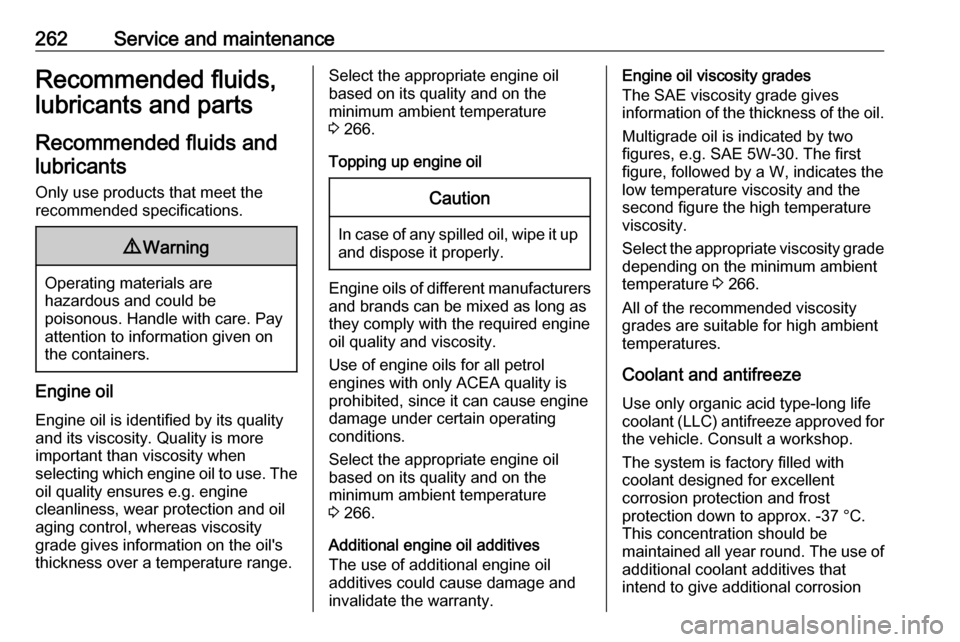
262Service and maintenanceRecommended fluids,lubricants and parts
Recommended fluids and lubricants
Only use products that meet the
recommended specifications.9 Warning
Operating materials are
hazardous and could be
poisonous. Handle with care. Pay
attention to information given on
the containers.
Engine oil
Engine oil is identified by its quality
and its viscosity. Quality is more
important than viscosity when
selecting which engine oil to use. The oil quality ensures e.g. engine
cleanliness, wear protection and oil
aging control, whereas viscosity
grade gives information on the oil's
thickness over a temperature range.
Select the appropriate engine oil
based on its quality and on the
minimum ambient temperature
3 266.
Topping up engine oilCaution
In case of any spilled oil, wipe it up and dispose it properly.
Engine oils of different manufacturersand brands can be mixed as long as
they comply with the required engine
oil quality and viscosity.
Use of engine oils for all petrol
engines with only ACEA quality is
prohibited, since it can cause engine
damage under certain operating
conditions.
Select the appropriate engine oil
based on its quality and on the
minimum ambient temperature
3 266.
Additional engine oil additives
The use of additional engine oil
additives could cause damage and
invalidate the warranty.
Engine oil viscosity grades
The SAE viscosity grade gives
information of the thickness of the oil.
Multigrade oil is indicated by two
figures, e.g. SAE 5W-30. The first
figure, followed by a W, indicates the
low temperature viscosity and the
second figure the high temperature viscosity.
Select the appropriate viscosity grade depending on the minimum ambient
temperature 3 266.
All of the recommended viscosity
grades are suitable for high ambient
temperatures.
Coolant and antifreeze
Use only organic acid type-long life
coolant (LLC) antifreeze approved for
the vehicle. Consult a workshop.
The system is factory filled with
coolant designed for excellent
corrosion protection and frost
protection down to approx. -37 °C.
This concentration should be
maintained all year round. The use of additional coolant additives that
intend to give additional corrosion
Page 283 of 287

281Climate control systems.............139
Clock............................................. 98
Control indicators........................ 110
Control of the vehicle .................153
Controls ........................................ 94
Convex shape .............................. 39
Coolant and antifreeze ...............262
Cornering lights .......................... 133
Cruise control ....................115, 174
Cupholders .................................. 78
Curtain airbag system .................. 65
D Danger, Warnings and Cautions ...4
Daytime running lights ...............133
Declaration of conformity ............273
DEF ............................................ 162
Deflation detection system .........114
Diesel exhaust fluid ....................162
Diesel fuel system bleeding .......219
Door open .................................. 116
Doors ...................................... 31, 33
Driver alert .................................. 201
Driver assistance systems ..........174
Driver Information Centre ...........116
Driving characteristics and towing tips .............................. 205
Driving hints ................................ 153E
Electric adjustment ......................39
Electrical system......................... 231
Electronic climate control system 143
Electronic driving programmes ..168
Electronic key system ...................24
Electronic Stability Control and Traction Control system ..113, 171
Emergency call ........................... 128
End-of-life vehicle recovery .......213
Engine compartment fuse box ...232
Engine coolant ........................... 215
Engine coolant temperature ......113
Engine coolant temperature gauge ..................................... 108
Engine data ............................... 268
Engine exhaust .......................... 161
Engine identification ...................265
Engine oil ................... 214, 262, 266
Engine oil level monitor ..............109
Engine oil pressure ....................114
Entry lighting .............................. 137
Event data recorders ..................275
Exhaust filter ....................... 113, 161
Exit lighting ................................ 137
Exterior care .............................. 253
Exterior light ............................... 115
Exterior lighting ....................13, 130
Exterior mirrors ............................. 39F
Fault ........................................... 168
Fixed air vents ........................... 150
Floor mats................................... 256
Folding front seat ..........................51
Folding mirrors ............................. 40
Folding tray .................................. 86
Forward collision alert................. 187
Front airbag system .....................64
Front fog lights ...........115, 134, 224
Front pedestrian protection ........191
Front seats.................................... 48
Front storage ................................ 79
Front turn lights .......................... 225
Fuel for diesel engines ..............203
Fuel gauge ................................. 107 Fuses ......................................... 231
G
Gauges ....................................... 105
Gear selection ........................... 166
Gear shifting ............................... 113
General information ...................205
Glass panel .................................. 46
Glovebox ..................................... 78
Glovebox cooler ......................... 150
H
Halogen headlights ....................220
Hand brake ................................. 170
Hazard warning flashers ............133
Page 284 of 287

282Headlight flash ........................... 132
Headlight range adjustment ......132
Headlights................................... 130 Headlights when driving abroad 133
Head restraint adjustment .............8
Head restraints ............................ 47
Head-up display.......................... 121 Heated mirrors ............................. 40
Heated rear window ..................... 44
Heated windscreen .......................45
Heating ........................................ 52
Heating and ventilation system . 139
High beam ......................... 115, 131
High beam assist ................115, 131
Hill start assist ........................... 171
Hinged doors ................................ 33
Horn ....................................... 14, 95
I
Identification plate .....................264
Ignition switch positions .............153
Immobiliser .................................. 39
Indicators .................................... 105
Info Display ................................. 120
Instrument cluster ......................101
Instrument panel fuse box .........232
Instrument panel illumination control .................................... 135
Instrument panel overview ........... 10
Interior care ............................... 255Interior lighting............................ 135
Interior lights ...................... 135, 230
Interior mirror Rear view camera display .......199
Interior mirrors .............................. 41
Introduction .................................... 3
J Jump starting ............................. 250
K Keys ............................................. 22
Keys, locks ................................... 22
L
Lane departure warning .....113, 200
Lashing eyes ............................... 82
LED headlights ........................... 115
Lighting features .........................137
Light switch ................................ 130
load compartment .......................135
Load compartment ................33, 81
Load compartment cover .............81
load compartment lighting ..........135
Loading ......................................... 51
Loading information .....................91
Low beam ................................... 115
Low fuel ..................................... 114M
Malfunction indicator light ..........111
Manual anti-dazzle ......................41
Manual mode ............................. 167
Manual seat adjustment ...............48
Manual transmission .................. 168
Massage ....................................... 53
mechanical child lock.................... 43 Mirror adjustment ........................... 9
Misted light covers .....................135
Multimedia .................................. 124
Multimedia Navi .......................... 124
N
New vehicle running-in ..............153
Number plate light .....................230
O Object detection systems ...........192
Odometer ................................... 106
Oil, engine .......................... 262, 266
Opel Connect.............................. 128
Outside temperature ....................97
Overrun cut-off ........................... 157
P Panoramic roof ............................. 46
Panoramic view system ..............196
Parking ................................ 21, 160
Parking assist ............................ 192
Parking brake ..................... 112, 170